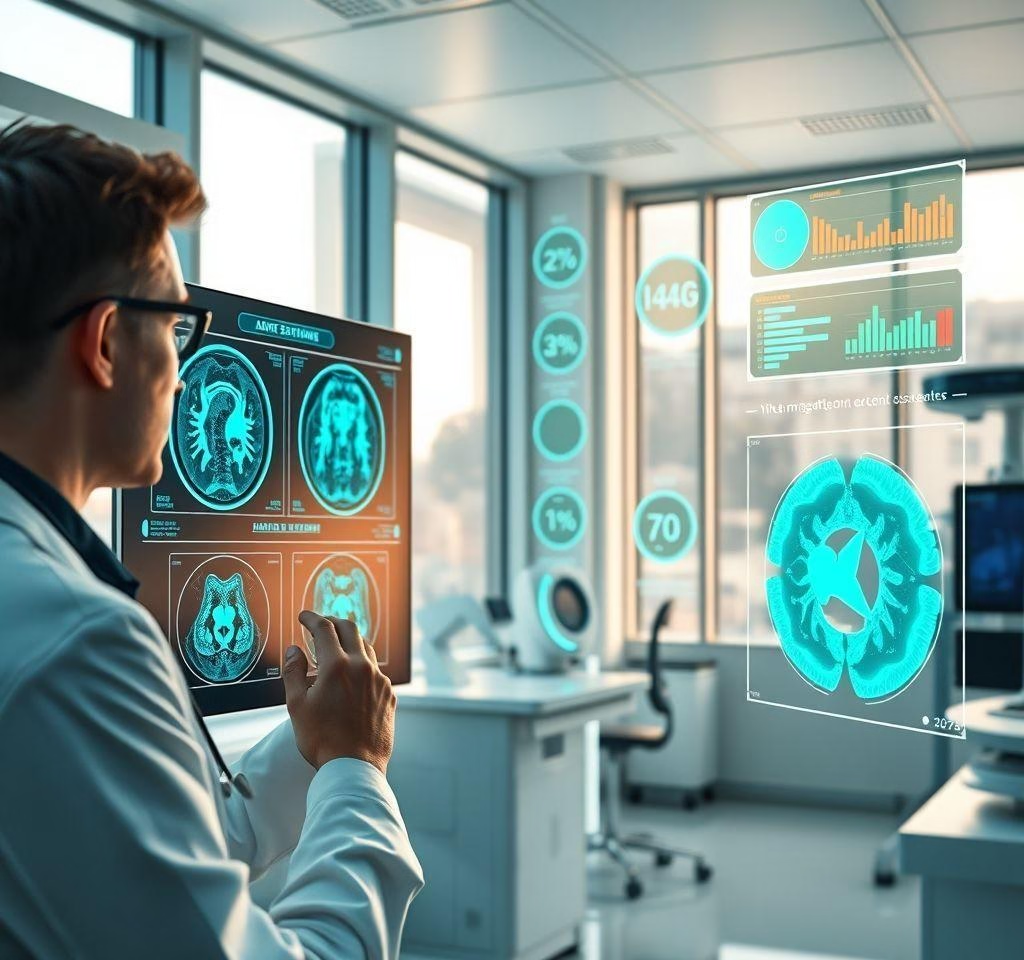AI in Radiology & Imaging: Revolutionizing Healthcare Through Precision
Artificial intelligence is reshaping medical imaging by addressing key clinical challenges: radiologist shortages, diagnostic variability, and interpretation overload. This article explores how AI-driven solutions are improving diagnostic accuracy, workflow optimization, and patient outcomes while addressing ethical and technical implementation challenges.
The Emergence of AI in Radiology
The Emergence of AI in Radiology: Current challenges include lengthy interpretation times, radiologist fatigue, and variability in diagnoses. AI’s role is transformative. Automated lesion detection accelerates workflows. Real-time image analysis provides immediate insights. Radiologist-AI collaboration optimizes accuracy and efficiency. AI assists, but does not replace, the expert. This collaborative approach enhances diagnostic confidence and improves patient care. AI addresses inherent human limitations, improving the overall quality of radiological services. The integration of AI is revolutionizing the field. It is improving diagnostic capabilities and overall patient experience.
Benefits of AI in Imaging
The Emergence of AI in Radiology: Current challenges include lengthy interpretation times, radiologist fatigue, and variability in diagnoses. AI’s role is transformative. Automated lesion detection accelerates workflows. Real-time image analysis provides immediate insights. Radiologist-AI collaboration optimizes accuracy and efficiency. AI assists, but does not replace, the expert. This collaborative approach enhances diagnostic confidence and improves patient care. AI addresses inherent human limitations, improving the overall quality of radiological services. The integration of AI is revolutionizing the field. It is improving diagnostic capabilities and overall patient experience.
Technical Foundations
The Emergence of AI in Radiology: Current challenges include lengthy interpretation times, radiologist fatigue, and variability in diagnoses. AI’s role is transformative. Automated lesion detection accelerates workflows. Real-time image analysis provides immediate insights. Radiologist-AI collaboration optimizes accuracy and efficiency. AI assists, but does not replace, the expert. This collaborative approach enhances diagnostic confidence and improves patient care. AI addresses inherent human limitations, improving the overall quality of radiological services. The integration of AI is revolutionizing the field. It is improving diagnostic capabilities and overall patient experience.
Clinical Applications
The Emergence of AI in Radiology: Current challenges include lengthy interpretation times, radiologist fatigue, and variability in diagnoses. AI’s role is transformative. Automated lesion detection accelerates workflows. Real-time image analysis provides immediate insights. Radiologist-AI collaboration optimizes accuracy and efficiency. AI assists, but does not replace, the expert. This collaborative approach enhances diagnostic confidence and improves patient care. AI addresses inherent human limitations, improving the overall quality of radiological services. The integration of AI is revolutionizing the field. It is improving diagnostic capabilities and overall patient experience.
Future Frontiers
The Emergence of AI in Radiology: Current challenges include lengthy interpretation times, radiologist fatigue, and variability in diagnoses. AI’s role is transformative. Automated lesion detection accelerates workflows. Real-time image analysis provides immediate insights. Radiologist-AI collaboration optimizes accuracy and efficiency. AI assists, but does not replace, the expert. This collaborative approach enhances diagnostic confidence and improves patient care. AI addresses inherent human limitations, improving the overall quality of radiological services. The integration of AI is revolutionizing the field. It is improving diagnostic capabilities and overall patient experience.
The Emergence of AI in Radiology
Benefits of AI in medical imaging are significant. Improved accuracy is a key advantage, with studies suggesting error reduction of up to 40%. This leads to more confident diagnoses and better patient outcomes. AI also enables faster reporting, streamlining workflows and reducing delays in treatment. Cost efficiencies are realized through automation and increased throughput. Furthermore, AI facilitates
- early disease detection, improving prognosis
- standardized protocols, ensuring consistency
. The technology is enhancing the efficiency and accuracy of radiological practices. It promises a future with improved healthcare delivery.
Benefits of AI in Imaging
Benefits of AI in medical imaging are significant. Improved accuracy is a key advantage, with studies suggesting error reduction of up to 40%. This leads to more confident diagnoses and better patient outcomes. AI also enables faster reporting, streamlining workflows and reducing delays in treatment. Cost efficiencies are realized through automation and increased throughput. Furthermore, AI facilitates
- early disease detection, improving prognosis
- standardized protocols, ensuring consistency
. The technology is enhancing the efficiency and accuracy of radiological practices. It promises a future with improved healthcare delivery.
Technical Foundations
Benefits of AI in medical imaging are significant. Improved accuracy is a key advantage, with studies suggesting error reduction of up to 40%. This leads to more confident diagnoses and better patient outcomes. AI also enables faster reporting, streamlining workflows and reducing delays in treatment. Cost efficiencies are realized through automation and increased throughput. Furthermore, AI facilitates
- early disease detection, improving prognosis
- standardized protocols, ensuring consistency
. The technology is enhancing the efficiency and accuracy of radiological practices. It promises a future with improved healthcare delivery.
Clinical Applications
Benefits of AI in medical imaging are significant. Improved accuracy is a key advantage, with studies suggesting error reduction of up to 40%. This leads to more confident diagnoses and better patient outcomes. AI also enables faster reporting, streamlining workflows and reducing delays in treatment. Cost efficiencies are realized through automation and increased throughput. Furthermore, AI facilitates
- early disease detection, improving prognosis
- standardized protocols, ensuring consistency
. The technology is enhancing the efficiency and accuracy of radiological practices. It promises a future with improved healthcare delivery.
Future Frontiers
Benefits of AI in medical imaging are significant. Improved accuracy is a key advantage, with studies suggesting error reduction of up to 40%. This leads to more confident diagnoses and better patient outcomes. AI also enables faster reporting, streamlining workflows and reducing delays in treatment. Cost efficiencies are realized through automation and increased throughput. Furthermore, AI facilitates
- early disease detection, improving prognosis
- standardized protocols, ensuring consistency
. The technology is enhancing the efficiency and accuracy of radiological practices. It promises a future with improved healthcare delivery.
The Emergence of AI in Radiology
Technical Foundations: The application of AI in radiology relies on several key elements. Deep learning algorithms, particularly convolutional neural networks, are fundamental for image analysis. These algorithms learn to identify patterns and features within medical images. Access to real-world datasets of high quality is crucial for training these models effectively. Sufficient data ensures robustness and accuracy. Cloud integration is essential for managing the vast amounts of data involved. It also allows for scalability and accessibility. Finally, the ethics of algorithm transparency must be addressed. This ensures responsible and accountable use of AI in healthcare.
Benefits of AI in Imaging
Technical Foundations: The application of AI in radiology relies on several key elements. Deep learning algorithms, particularly convolutional neural networks, are fundamental for image analysis. These algorithms learn to identify patterns and features within medical images. Access to real-world datasets of high quality is crucial for training these models effectively. Sufficient data ensures robustness and accuracy. Cloud integration is essential for managing the vast amounts of data involved. It also allows for scalability and accessibility. Finally, the ethics of algorithm transparency must be addressed. This ensures responsible and accountable use of AI in healthcare.
Technical Foundations
Technical Foundations: The application of AI in radiology relies on several key elements. Deep learning algorithms, particularly convolutional neural networks, are fundamental for image analysis. These algorithms learn to identify patterns and features within medical images. Access to real-world datasets of high quality is crucial for training these models effectively. Sufficient data ensures robustness and accuracy. Cloud integration is essential for managing the vast amounts of data involved. It also allows for scalability and accessibility. Finally, the ethics of algorithm transparency must be addressed. This ensures responsible and accountable use of AI in healthcare.
Clinical Applications
Technical Foundations: The application of AI in radiology relies on several key elements. Deep learning algorithms, particularly convolutional neural networks, are fundamental for image analysis. These algorithms learn to identify patterns and features within medical images. Access to real-world datasets of high quality is crucial for training these models effectively. Sufficient data ensures robustness and accuracy. Cloud integration is essential for managing the vast amounts of data involved. It also allows for scalability and accessibility. Finally, the ethics of algorithm transparency must be addressed. This ensures responsible and accountable use of AI in healthcare.
Future Frontiers
Technical Foundations: The application of AI in radiology relies on several key elements. Deep learning algorithms, particularly convolutional neural networks, are fundamental for image analysis. These algorithms learn to identify patterns and features within medical images. Access to real-world datasets of high quality is crucial for training these models effectively. Sufficient data ensures robustness and accuracy. Cloud integration is essential for managing the vast amounts of data involved. It also allows for scalability and accessibility. Finally, the ethics of algorithm transparency must be addressed. This ensures responsible and accountable use of AI in healthcare.
The Emergence of AI in Radiology
Clinical Applications: AI is rapidly transforming clinical radiology. Breast cancer detection benefits significantly from AI’s ability to analyze mammograms for subtle anomalies. AI algorithms can improve the accuracy and efficiency of detecting cancerous lesions. Similarly, AI aids in MRI stroke analysis. It can quickly identify and quantify stroke volume and location. This speeds up treatment decisions and improves patient outcomes. The integration of telemedicine is another key area. AI enables remote diagnostics, expanding access to specialist care. AI-powered image analysis allows radiologists to interpret images from remote locations. This is particularly valuable in underserved areas. Overall, AI is enhancing diagnostic capabilities and improving patient care across various specialties.
Benefits of AI in Imaging
Clinical Applications: AI is rapidly transforming clinical radiology. Breast cancer detection benefits significantly from AI’s ability to analyze mammograms for subtle anomalies. AI algorithms can improve the accuracy and efficiency of detecting cancerous lesions. Similarly, AI aids in MRI stroke analysis. It can quickly identify and quantify stroke volume and location. This speeds up treatment decisions and improves patient outcomes. The integration of telemedicine is another key area. AI enables remote diagnostics, expanding access to specialist care. AI-powered image analysis allows radiologists to interpret images from remote locations. This is particularly valuable in underserved areas. Overall, AI is enhancing diagnostic capabilities and improving patient care across various specialties.
Technical Foundations
Clinical Applications: AI is rapidly transforming clinical radiology. Breast cancer detection benefits significantly from AI’s ability to analyze mammograms for subtle anomalies. AI algorithms can improve the accuracy and efficiency of detecting cancerous lesions. Similarly, AI aids in MRI stroke analysis. It can quickly identify and quantify stroke volume and location. This speeds up treatment decisions and improves patient outcomes. The integration of telemedicine is another key area. AI enables remote diagnostics, expanding access to specialist care. AI-powered image analysis allows radiologists to interpret images from remote locations. This is particularly valuable in underserved areas. Overall, AI is enhancing diagnostic capabilities and improving patient care across various specialties.
Clinical Applications
Clinical Applications: AI is rapidly transforming clinical radiology. Breast cancer detection benefits significantly from AI’s ability to analyze mammograms for subtle anomalies. AI algorithms can improve the accuracy and efficiency of detecting cancerous lesions. Similarly, AI aids in MRI stroke analysis. It can quickly identify and quantify stroke volume and location. This speeds up treatment decisions and improves patient outcomes. The integration of telemedicine is another key area. AI enables remote diagnostics, expanding access to specialist care. AI-powered image analysis allows radiologists to interpret images from remote locations. This is particularly valuable in underserved areas. Overall, AI is enhancing diagnostic capabilities and improving patient care across various specialties.
Future Frontiers
Clinical Applications: AI is rapidly transforming clinical radiology. Breast cancer detection benefits significantly from AI’s ability to analyze mammograms for subtle anomalies. AI algorithms can improve the accuracy and efficiency of detecting cancerous lesions. Similarly, AI aids in MRI stroke analysis. It can quickly identify and quantify stroke volume and location. This speeds up treatment decisions and improves patient outcomes. The integration of telemedicine is another key area. AI enables remote diagnostics, expanding access to specialist care. AI-powered image analysis allows radiologists to interpret images from remote locations. This is particularly valuable in underserved areas. Overall, AI is enhancing diagnostic capabilities and improving patient care across various specialties.
The Emergence of AI in Radiology
Future Frontiers: The future of AI in radiology and imaging holds immense potential. Generative AI will advance 3D imaging, creating more realistic and detailed models from various image modalities. This can improve diagnostic accuracy and surgical planning. Quantum computing‘s superior processing power will revolutionize data analysis. It will enable faster processing of massive datasets, leading to quicker diagnostic turnaround times. The development of intuitive patient-AI interaction interfaces will improve patient engagement and experience. AI-powered assistants can answer patients’ questions and provide personalized information. This enhanced communication will contribute to improved satisfaction and adherence to treatment plans. The integration of these technologies promises significant advancements in the field, enhancing diagnostic capabilities and improving patient care.
Benefits of AI in Imaging
Future Frontiers: The future of AI in radiology and imaging holds immense potential. Generative AI will advance 3D imaging, creating more realistic and detailed models from various image modalities. This can improve diagnostic accuracy and surgical planning. Quantum computing‘s superior processing power will revolutionize data analysis. It will enable faster processing of massive datasets, leading to quicker diagnostic turnaround times. The development of intuitive patient-AI interaction interfaces will improve patient engagement and experience. AI-powered assistants can answer patients’ questions and provide personalized information. This enhanced communication will contribute to improved satisfaction and adherence to treatment plans. The integration of these technologies promises significant advancements in the field, enhancing diagnostic capabilities and improving patient care.
Technical Foundations
Future Frontiers: The future of AI in radiology and imaging holds immense potential. Generative AI will advance 3D imaging, creating more realistic and detailed models from various image modalities. This can improve diagnostic accuracy and surgical planning. Quantum computing‘s superior processing power will revolutionize data analysis. It will enable faster processing of massive datasets, leading to quicker diagnostic turnaround times. The development of intuitive patient-AI interaction interfaces will improve patient engagement and experience. AI-powered assistants can answer patients’ questions and provide personalized information. This enhanced communication will contribute to improved satisfaction and adherence to treatment plans. The integration of these technologies promises significant advancements in the field, enhancing diagnostic capabilities and improving patient care.
Clinical Applications
Future Frontiers: The future of AI in radiology and imaging holds immense potential. Generative AI will advance 3D imaging, creating more realistic and detailed models from various image modalities. This can improve diagnostic accuracy and surgical planning. Quantum computing‘s superior processing power will revolutionize data analysis. It will enable faster processing of massive datasets, leading to quicker diagnostic turnaround times. The development of intuitive patient-AI interaction interfaces will improve patient engagement and experience. AI-powered assistants can answer patients’ questions and provide personalized information. This enhanced communication will contribute to improved satisfaction and adherence to treatment plans. The integration of these technologies promises significant advancements in the field, enhancing diagnostic capabilities and improving patient care.
Future Frontiers
Future Frontiers: The future of AI in radiology and imaging holds immense potential. Generative AI will advance 3D imaging, creating more realistic and detailed models from various image modalities. This can improve diagnostic accuracy and surgical planning. Quantum computing‘s superior processing power will revolutionize data analysis. It will enable faster processing of massive datasets, leading to quicker diagnostic turnaround times. The development of intuitive patient-AI interaction interfaces will improve patient engagement and experience. AI-powered assistants can answer patients’ questions and provide personalized information. This enhanced communication will contribute to improved satisfaction and adherence to treatment plans. The integration of these technologies promises significant advancements in the field, enhancing diagnostic capabilities and improving patient care.
Final Words
AI in radiology is not a replacement but a collaborator: enhancing productivity (20% faster reads), 15% error reduction), and triage capabilities). Challenges in data standardization and regulatory frameworks remain, but the benefits of augmented human-AI teams make adoption imperative for modern healthcare systems.




